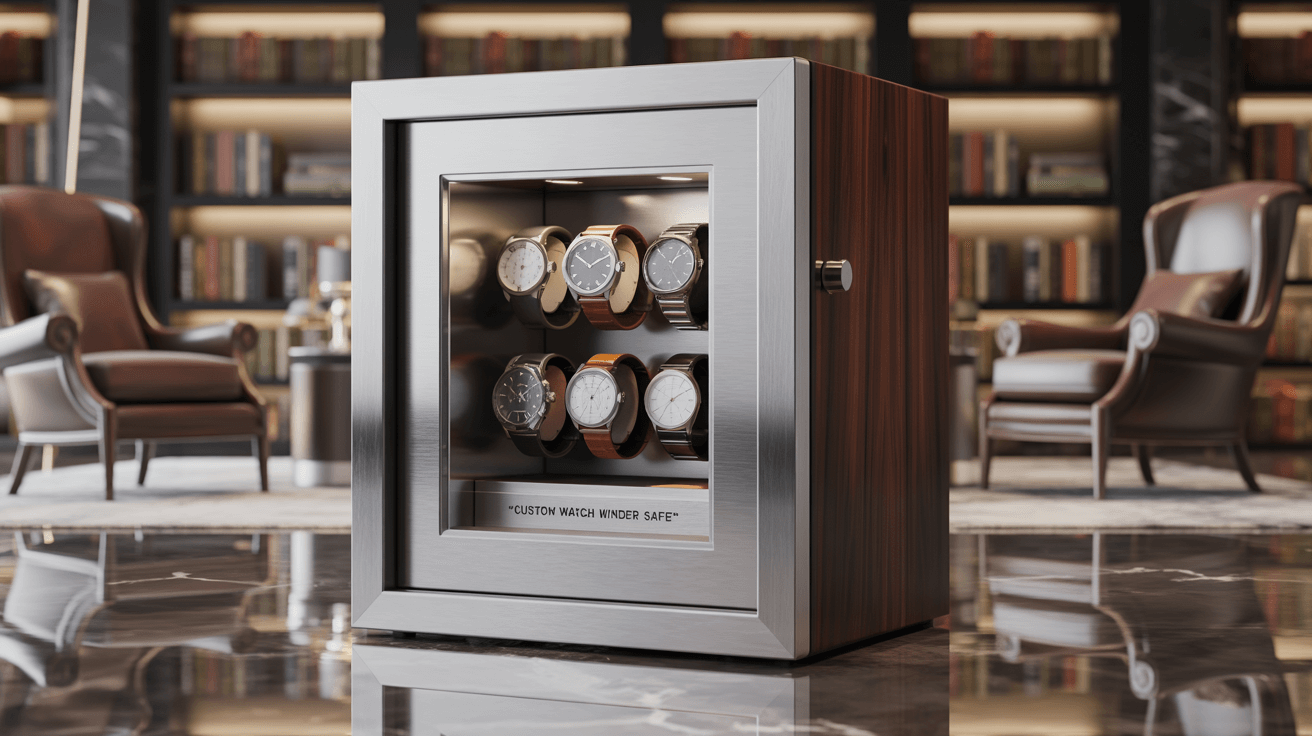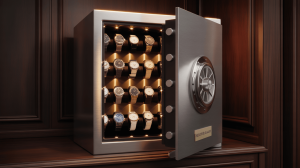Affordable Custom Watch Winder Safe Options without Compromising Quality. But here’s the kicker… You can enjoy tailored winding performance, robust protection, and elegant presentation—all within an affordable budget.
1. Understanding Budget-Friendly Customization
Custom doesn’t always mean costly. Many manufacturers offer entry-level bespoke options—choose your safe’s capacity, finish, and winding specs at a fraction of premium prices. By selecting standard veneer panels or powder-coat finishes instead of exotic woods or leathers, you reduce cost without sacrificing design integrity. Focus spending on core features—security rating and winder quality—and leave decorative upgrades for later.
| Custom Element | Budget Option | Cost Savings |
|---|---|---|
| Exterior Finish | Powder-coat steel | 30–50% less than wood veneer |
| Interior Lining | Velvet or foam | Affordable and protective |
| Winding Modules | Standard Mabuchi motors | Reliable under $100 per tray |
2. Assessing Your Collection’s Requirements
Start by cataloging how many automatics need winding versus static storage. A small collection of 2–4 watches may only need one or two winding trays; larger assortments require modular expansion. Decide whether you also want jewelry drawers or tool compartments. Matching capacity precisely to your needs avoids paying for unused bays and keeps the safe footprint compact.
3. Prioritizing Security Certifications on a Budget
Even affordable safes can carry UL RSC or ETL burglary ratings. Look for models tested against common theft tools for 5–10 minutes of forced-entry delay. If full certification exceeds your budget, select reputable brands with signed test reports or equivalent European standards (e.g., EN 14450). Mechanical combination dials or simple electronic keypads deliver reliable access control without premium biometric premiums.
4. Fire and Climate Protection Essentials
Protecting movements and gemstones from heat and humidity doesn’t require top-tier insulation. Many mid-priced safes include composite fireboard liners rated UL 72 Class 350 for 30 minutes at up to 1,200 °F. Simple intumescent door gaskets and foam-seal strips block smoke and moisture effectively.
| Feature | Basic Option | Performance |
|---|---|---|
| Fireboard Liner | Standard composite board | 30 min @ 1,200 °F protection |
| Door Gasket | Foam seal strip | Dust and light moisture barrier |
| Climate Seal | Manual desiccant chamber | Maintains RH ~50% |
5. Material and Finish Choices for Value
Steel-powder-coat safes in matte black or grey offer sleek looks and scratch resistance. For a warmer feel, look for mid-range models with walnut or oak veneer overlays—these veneers often come as an optional add-on rather than standard, reducing cost. Avoid full leather wraps at entry level; instead add a leather trim around the door for a touch of luxury without the full premium.
6. Efficient Interior Organization
A tidy interior multiplies value. Choose safes with adjustable foam inserts and modular watch pillows that you can relocate as your collection grows. Many budget options include removable trays that convert between winding modules and static pillows—no extra spend on separate inserts. Hidden pockets beneath trays keep straps and tools organized, eliminating the need for separate accessory cases.
7. Watch Winder Module Essentials
Affordable custom safes often use reliable Mabuchi motors with adjustable turns-per-day (650–1,200 TPD) and simple directional control (CW or bi-directional). Though premium Swiss motors cost more, these budget-friendly units maintain accuracy and quiet operation below 30 dB.
| Specification | Budget Module | Benefit |
|---|---|---|
| TPD Range | 650–1,200 | Covers most automatic calibers |
| Direction Control | CW & bi-directional | Prevents overwinding |
| Noise Level | < 30 dB | Quiet enough for bedroom use |
8. Noise and Vibration Management
Even lower-cost winders can run quietly. Look for vibration-dampening rubber mounts and sealed motor housings. Soft-close hinges and foam door seals reduce rattles. Read user reviews to verify actual in-room noise—manufacturers’ decibel specs on budget models can be optimistic.
9. Smart Connectivity Lite Options
Full Bluetooth/Wi-Fi modules often double the price. Instead, some affordable safes offer local tamper alarms or basic Bluetooth with a simple LED alert when the door opens. For remote monitoring, a standalone Wi-Fi sensor inside the safe can trigger push notifications without paying for factory-integrated smart hubs.
10. Power and Backup Strategies
Entry-level electronic safes use AA batteries; mid-range units add rechargeable battery packs. USB-C power banks work universally as backup. Always ensure an included mechanical override key or combination fallback in case electronics fail.
| Power Source | Backup Method | Cost Consideration |
|---|---|---|
| AA Batteries | Replace annually | Inexpensive and widely available |
| Rechargeable Pack | USB-C auxiliary | Moderate cost, reusable |
| Mechanical Override | Key or dial | No ongoing expense |
11. Installation and Anchoring Best Practices
Even budget safes require anchoring. Bolt units into studs using heavy-duty lag bolts or masonry anchors for concrete walls. Pre-drill pilot holes to avoid splitting wood. Level the safe before tightening to prevent door binding. Conceal anchor heads under the interior lining for a polished finish.
12. Warranty and Support Considerations
Mid-price custom options often include 1–3 year warranties. Verify that electronics and mechanical components are covered. Check if the manufacturer or reseller offers online support, spare parts availability, and clear return policies. A solid warranty can offset minor feature compromises.
13. Maintenance and Longevity Tips
Keep exterior clean with mild detergent and microfiber cloth. Dust interior monthly and test locks quarterly. Replace batteries and desiccant packs every 6–12 months. Run winders empty for a short cycle each month to keep motors from seizing. These simple routines extend safe life without added cost.
14. Aesthetic Integration into Home Décor
Affordable safes may limit finish choices, but many offer neutral tones—matte black, grey, or dark wood—that blend into modern or traditional interiors. Add LED accent lights or a decorative mat under the safe to enhance presence. Even basic models can feel bespoke with the right placement and styling.
| Décor Style | Recommended Finish | Accent Tip |
|---|---|---|
| Minimalist | Matte Black | Under-shelf LED strip |
| Traditional | Dark Wood Veneer | Styled atop matching cabinet |
| Contemporary | Brushed Grey Steel | Complement with metal accents |
15. Final Selection and Decision Checklist
Compile your must-haves—capacity, certification, winding specs, organization, noise level, power backup, finish, installation, warranty, and budget—into a comparison table. Score shortlisted safes by how well they meet each criterion. This structured approach ensures you choose an affordable custom safe that meets all essential requirements without overpaying for extras.
Conclusion
Affordable custom watch winder safes prove you can have tailored protection, precise winding, and stylish presentation without breaking the bank. Here’s the deal… focus on core features and smart compromises to enjoy a bespoke vault that safeguards and showcases your collection for years to come.
FAQ
Q1: Can I get fire protection on a budget safe?
Yes—many under $500 include UL 72 Class 350 liners for 30 minutes’ heat defense.
Q2: Are budget winding modules reliable?
Reputable Mabuchi-motor units offer quiet, accurate winding suitable for most automatics.
Q3: How often change batteries?
Replace AA batteries annually; recharge auxiliary packs every 6–12 months.
Q4: Do entry-level safes include anchoring hardware?
Most do—verify that lag bolts or sleeve anchors are included before purchase.
Q5: Can I upgrade a basic safe later?
Look for models with modular interiors that accept add-on winders, trays, or sensors.







